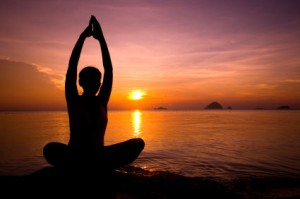
HATHA means ‘energetic’ and it is the basis of all forms of physical yoga that focus on the body. It’s primary purpose is to move prana or energy through the body using held postures and breathing. What to expect Classes usually go for 60-90 minutes and include breath awareness, a warm-up to open the joints and muscles and prepare and open the body, a series of postures held for anything from one to 20 breaths, relaxation, breathing and perhaps some meditation at the end. Postures are usually slow and deep and not as dynamic as styles such as Ashtanga or Anusara. Teacher’s tip Opt for a 6-8 week Beginner’s Course before you attend classes (or read a book like this!) to teach you the fundamentals of breath and alignment so that you can attend classes with confidence.
IYENGAR Developed in Pune, India by BKS Iyengar, this style is all about correct alignment and the finer details of postures. It utilizes props such as blocks, chairs, bolsters and ropes to help release and align the body in postures that are held for 6-20 breaths or even longer. It’s challenging but deeply effective. What to expect There are no sun salutations in this precise system and be warned, teachers sometimes have an idiosyncratic style known for it’s abruptness in dealing out instructions. Don’t take it personally! Some classes may look closely at only a few postures to correct your alignment in them which can positively affect your practice overall. Expect to feel muscles you didn’t know you had. Good for People who love detail and precision and also want to stretch deeply. Teacher’s tip Make sure your teacher is correctly accredited as this system requires specialist knowledge. Find one at iyengaryoga.org.uk
ASTANGA Created in 1948 by Sri K. Pattabhi Jois, another of yoga’s modern founding fathers, it involves a series of around 50 postures practiced in order. Sometimes referred to as ‘power’ or ‘vinyasa’ yoga it’s a dynamic, flowing sequence that creates heat and sweat in the body and leaves you feeling stretched and invigorated. What to expect Up to seven rounds of two types of sun salutations make the body hot then a series of challenging standing, sitting, twisting, inverted and supine postures are held for five breaths each. Classes are rarely less than 90 minutes and can sometimes run to two hours. Great for sporty types, those wanting to get into shape quickly, anyone who likes to sweat and those who thrive on routine and structure. Teacher’s tip People with competitive, type-A personalities – including myself – are often drawn to Ashtanga yoga. Be careful not to practice with ego and stay at your own pace. Don’t mimic experienced astanga yogis in your class – they do astoundingly pretzel-like postures that require strength and skill. Be careful not to run before you can walk in this system.
ANUSARA A relatively new style founded by California-based John Friend in 1997, it’s influenced by Iyengar in its focus on alignment. Anusara literally means ‘flowing with grace’ and is an uplifting form that emphasizes flowing, heart opening postures. What to expect An energising yoga class experience that works your body deeply, so you will sweat. Classes emphasise bending, rotating and twisting of the spine and correct alignment. Be prepared also, for chanting, breath work, meditation and music (both modern and yogic!) so your mind is fully engaged along with your body. Great for people wanting a deep workout that is guaranteed to also elevate your mood and introduce you to yogic philosophy in practice. Teacher’s tip One of my favourite new styles, a good Anusara teacher will make your body feel lean, stretched and opened and also talk about ways to apply your practice to your everyday life.
SIVANANDA Based on the teachings of Swami Sivananda who developed it in the middle of last century, it’s a slow, considered form of yoga designed for health and wellness. It’s emphasis is on balancing postures with breathing techniques, relaxation and meditation. What to expect Classes tend to start and end in The Corpse pose (lying supine with optional blankie) which is also practiced intermittently between the more challenging postures to ensure the body is adequately relaxed after working hard. Breathing practices are done at the start of the class and only 12 basic postures are then practiced, intended to open the energy channels of the body. Anyone wanting more serenity and a yoga experience that balances the fundamentals of breath and meditation with posture practice will like this. Teacher’s tip Sivananda is a great choice if you’re interested in finding out more about yogic diet and philosophy.
RESTORATATIVE A series of long-held and supported postures designed to relieve chronic stress and tiredness and restore energy. What to expect Postures are held for up to 15 minutes with the use of props to encourage full support and relaxation such as blankets, eye covers, bolsters, blocks and bricks. Classes are a warm, comforting atmosphere (sometimes the lights are dimmed and candles lit) but beginners sometimes find classes intimidating because of the intense stillness. If you perservere, the rewards are great. Good for people feeling frazzled and as though they lack ‘space’ in their daily lives. Anyone suffering from insomnia and stress. Yogis who practice more dynamic styles to help balance out the body. Teaching Tip Judith Lasater’s book Relax and Renew: Restful Yoga for Stressful Times is a fantastic reference to get you started.
Find a teacher: British Wheel of Yoga Yoga Alliance Yogaalliance.co.uk
Anna Magee is Healthista’s Editor-in-Chief and author of Shape Up With Yoga £7.99 in WH Smith’s now
Like this article? Sign up to our newsletter to get more articles like this delivered straight to your inbox.




















































